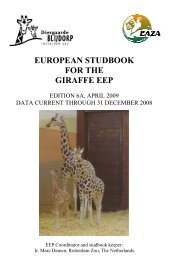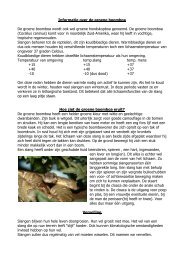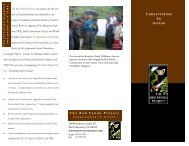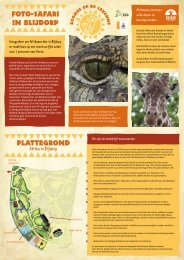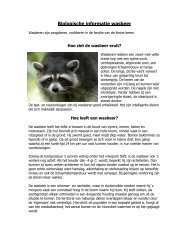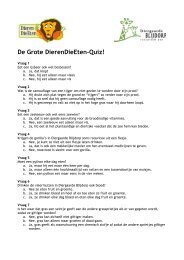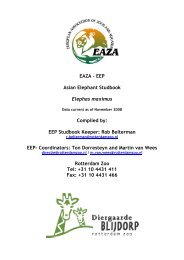Create successful ePaper yourself
Turn your PDF publications into a flip-book with our unique Google optimized e-Paper software.
<strong>EEP</strong> STUDBOOK CROWNED PIGEONS<br />
6.5 Information on crowned <strong>pigeon</strong>s in Papua New Guinea<br />
6.5.1 Ecology of crowned <strong>pigeon</strong>s<br />
<strong>Crowned</strong> <strong>pigeon</strong>s occur in the swampy lowland forests of New Guinea until a height of<br />
maximal 500 meters above sea level (Wetzel, 1992a). Because New Guinea is very<br />
mountainous, with mountains up to 4,500 meters in the heart of the island, crowned <strong>pigeon</strong>s<br />
can only be found along the coasts of New Guinea. They are real ground-dwellers, because it<br />
is very energy consuming to fly for a bird of this size. They are turkey-sized and in good<br />
condition crowned <strong>pigeon</strong>s weigh about 2 - 2.5 kilograms (Weekers, 1991), although Grzimek<br />
(1974) states that their weight is about 1.3 kilograms, which is definitely false for a mature<br />
crowned <strong>pigeon</strong>. They only fly if necessary: to sleep, to fly and to produce offspring. When<br />
they fly they make a very clumsy impression and they have to take great pains to land safely<br />
and not to drop off the branch (Rand and Gilliard, 1967). Although no research has been done<br />
to the use of space in the wild, they do not seem to be territorial. They are said to live in<br />
groups during the year, and in the breeding season they look for a suitable place to brood, not<br />
in the neighbourhood of another nest. It is not likely that they will allow any other crowned<br />
<strong>pigeon</strong> in the neighbourhood of the nest, but no research has been done into this subject.<br />
Social behaviour<br />
Although most zoos keep their crowned <strong>pigeon</strong>s in pairs, in the wild they are often found in<br />
groups up to about ten individuals (Rand and Gilliard, 1967; Goodwin, 1983; Coates, 1985),<br />
but also groups of ten up to thirty individuals have been found (Coates, 1985). Probably in<br />
this way young crowned <strong>pigeon</strong>s can choose their own partner (Nijboer, pers. comm.).<br />
Research has been done on the time-budgets of crowned <strong>pigeon</strong>s in captivity and it became<br />
clear that crowned <strong>pigeon</strong>s, as well in a small as in a big enclosure, have an almost mixed<br />
daily rhythm, which is displayed every day (Stockwell, 1996).<br />
In aggressive as well as defensive threat display, one or both wings are raised and the tail is<br />
jerked up and down. This movements appear to be the equivalent of the similar and probably<br />
homologous tail movements of the green <strong>pigeon</strong>s Treron and the wing twitching in agnostic<br />
and sexual situations of other <strong>pigeon</strong>s (Goodwin, 1983).<br />
Feeding<br />
In their feeding behaviour they do not differ significantly from other forest dwelling and<br />
largely ground living <strong>pigeon</strong>s (Goodwin, 1983). <strong>Crowned</strong> <strong>pigeon</strong>s feed on fruits (mainly figs)<br />
and seeds of the ground, by foraging. Also in zoos it could be observed that crowned <strong>pigeon</strong>s<br />
spend a lot of time foraging. Their relatively long bill is very useful for this purpose. They do<br />
not scratch for feed with their feet but only shift the substrate, if it is loose and friable, with a<br />
sideways flicking movement of the bill (Goodwin, 1983). Furthermore they are said to feed<br />
on small insects, and one reference even reports that scheepmaker's crowned <strong>pigeon</strong>s should<br />
eat small crabs (Grant in Coates, 1985), but this has never been confirmed.<br />
Almost nothing is known about the composition of the diet of crowned <strong>pigeon</strong>s, neither in the<br />
wild nor in captivity (Hallebeek and Nijboer, 1996).<br />
113



